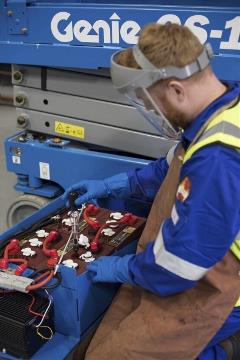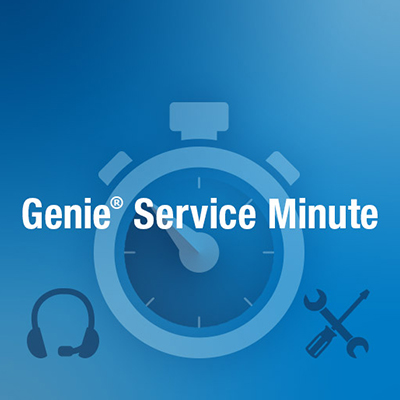Service Minute: Repair Guidelines for Water-Damaged MEWPs
by Genie On Jan 18, 2019, 03:00 AM
Subscribe To Aerial Pros
Filter by tags
Water damage due to submersion or other extreme water exposure can be harmful to a mobile elevated work platform (MEWP). In many cases, an aerial equipment manufacturer’s warranty is void for any components and/or systems damaged from a machine becoming partially or completely submerged in water. This is because it’s impossible for anyone to know the full extent of damage to a machine that has been fully or partially submerged in water without a complete disassembly, thorough visual inspection, repair, and function test of the affected components and/or systems.
Depending largely on the depth and duration of submersion, some obvious areas of concern are:
- Electrical components
- Hydraulic components
- Structural components
In the event that a MEWP in your rental fleet suffers from water damage, the following guidelines may be useful in repairing it back to full working condition. First, you need to determine what should be replaced. Here’s a method you can use:
- Mark the highest point of submersion for future reference during repair procedures. If such an indication is not evident, assume the machine was fully submerged.
- Thoroughly clean and visually inspect the machine to remove all mud, corrosion and debris. Significant effort should be made to thoroughly clean all surfaces exposed to flood waters to prevent latent degradation of paint and hardware due to corrosion.
Once you have completed those steps above, it’s time to look inside the MEWP and complete the following action items:
- Replace any and all electrical circuit components for which any part has been submerged in water including, but not limited to:
- Control systems and boxes
- Motors, brakes and any drive controllers
- Machine controls
- Switches, sensors, and power cables
- Ignition Start Module, fuses and fuse panel
- Batteries
- Cables, chain, pulleys and sheaves
- Disassemble, clean, and inspect all pinned joints, all boom sections, and all bearing surfaces that have been submerged. Replace any and all wear pads, hardware, chains/cables, and any damaged components. Clean, lubricate, and reassemble as required.
- Drain and remove the covers from drive/torque hubs and inspect for water intrusion. If water is present, disassemble the gearbox, clean and inspect for damage. Replace any damaged components. Refill per service manual.
- For telescopic and articulating booms, replace turntable bearing if submerged.
- Disassemble and inspect the Turntable Rotation Drive if submerged. Clean and inspect for damage. Replace any damaged components and refill per service manual.
- Remove all hydraulic cylinders, rotators, brakes, motors, pumps, manifolds and valves if submerged. Have these components repaired by a qualified hydraulic repair facility. Replace all load holding valves (counterbalance valves) on all cylinders.
- Replace the hydraulic power unit(s) if submerged.
- Drain the entire hydraulic system if submerged. Clean and inspect the reservoir, refill and change filters per service manual.
- Drain the entire fuel system if submerged. Clean and inspect the tank, refill and change filters per service manual.
- Contact the engine manufacturer for repair recommendations. If the engine was submerged, they may recommend replacing the engine depending upon how far it was submerged.
- When all repairs are complete, an Annual Inspection must be performed before returning the machine to service.
- Sample the hydraulic oil and fuel after 1 hour of functional operation. Have these samples analyzed by a lab and follow their recommendations regarding oil changes, filtration intervals, or supplemental additives until a clean, water free, system is established.
 It is important to note that if the MEWP was exposed to saltwater, it may be impossible to overcome the long-term corrosive effects on painted surfaces and hardware. Consideration should be given to refurbishment including complete disassembly, component/system replacement, media blast, new paint and new hardware.
It is important to note that if the MEWP was exposed to saltwater, it may be impossible to overcome the long-term corrosive effects on painted surfaces and hardware. Consideration should be given to refurbishment including complete disassembly, component/system replacement, media blast, new paint and new hardware.
Ultimately, the machine owner is responsible for any repairs made and for the maintenance of, as well as the safe operation of, the MEWP.
To receive a copy of the Genie Water Damage Repair Checklists or to speak to our Product Support team about your water-damaged Genie MEWPs, please contact us by phone at (800) 536-1800 or via email at awp.technicalsupport@terex.com.
Related Posts

Service Minute: Aerial Equipment Reliability Tips
Having worked in the Genie® field and phone support for over 20 years, I’ve noticed a couple of things about machine reliability
Continue Reading

Service Minute: Repairing Steel Platform Guard Rails on Genie® MEWPs
Rental applications often include demanding tasks that increase the risk of damage for mobile elevating work platforms (MEWPs) on jobsites.
Continue Reading

Service Minute: The Importance of Technician Training Programs
Training in the aerial industry is very important — a life is at stake each and every time someone gets into a piece of aerial equipment.
Continue Reading

